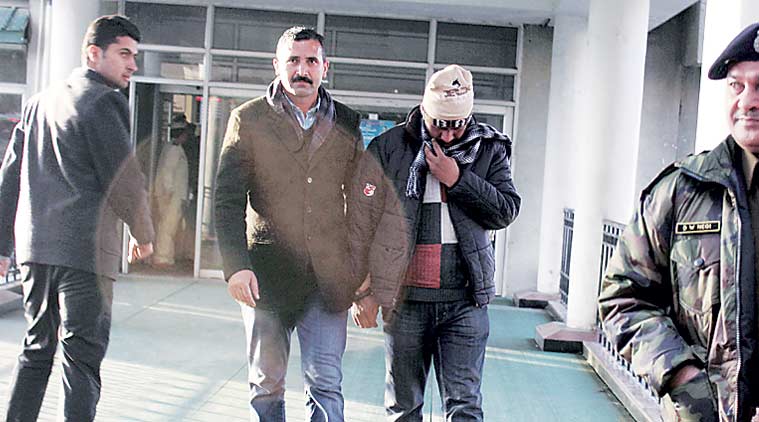- India
- International
Behind Shimla jaundice outbreak: waste in drinking water
Over 1,100 cases, seven deaths reported so far, hill station tourism hit.
 Akshay Doegar, the contractor of the sewerage treatment plant, has been arrested. (Express Photo by: Lalit Kumar)
Akshay Doegar, the contractor of the sewerage treatment plant, has been arrested. (Express Photo by: Lalit Kumar)
Eight years ago, a team of scientists from Pune raised the first red flag on jaundice in Shimla, warning in a report that untreated sewage water was being discharged into the supply system. The alert went unheeded.
Since then, the Himachal capital has seen an acute jaundice breakout in 2007-2008, 2010-11 and 2013, with the latest spell in December reportedly leading to seven deaths and affecting at least 1,150 people — from daily-wage earners to top bureaucrats.
While hoteliers worry about dipping tourist numbers, the outbreak has stalled even the government, with over 135 employees of the state secretariat among those affected. On Tuesday, Additional Chief Secretary Narinder Chauhan was among the latest on the list of confirmed cases at the Indira Gandhi Medical College (IGMC) hospital.
The Health Department has officially pegged the death toll this year at two but among the seven reported deaths due to jaundice are a pregnant woman and the only daughter of a senior state tax officer.
[related-post]
According to senior officials, the reason for the outbreak is clear: the release of untreated water from the Sewage Treatment Plant (STP) in Malyana, 4 km upstream, into Ashwani Khad, the main source of drinking water supplied by the Irrigation and Public Health (IPH) department.

Officials claim Shimla no longer uses water from that source, that the facilities will be upgraded and that the contractor operating the plant has been arrested on charges of alleged corruption and criminal negligence. But no one has an answer to why no action was taken ever since a team from Pune’s National Institute of Virology first collected samples to study the outbreak of 2007.
There was a second warning in 2008 when an expert panel set up by the High Court pointed to “serious lapses” in the operation of the Malyana plant. And a third red flag in 2010 from the Centre for Science and Environment (CSE) which also recommended updgradation of the system to avoid contamination.
Shimla’s Superintendent of Police, D W Negi, told The Indian Express, “The plant never functioned and sewage was discharged without any chemical or biological treatment. Interrogations have revealed that the private contractor running the plant, Ashish Doegar, is the main culprit. He was charging over Rs 1.4 crore per annum for running five STPs, including the Malyana plant. The actual operational costs would have been hardly Rs 40 lakh. It’s a case of corruption.”
Negi said investigations also point to a “series of lapses” at the plant and an alleged “nexus” between IPH department staff and the contractor. He added that the operation of the plant was outsourced to a number of private contractors since 2005 and most recently in 2013 for a period of three years to Doegar, a local hotelier and businessman.
“The plant was nearly defunct. The contractor had no technical expertise or skilled manpower. The chemicals used were either outdated or past their expiry date. The biological treatment process was a sham. This is a combination of cheating by the contractor and sheer carelessness of IPH staff, who failed to monitor the work or may have been mixed up with the accused,” said Negi.
Negi added that police have set up a Special Investigation Team (SIT) to investigate the lapses following an FIR lodged by Shimla’s Mayor Sanjay Chauhan and Deputy Mayor Tikender Panwar.
“Five people have been arrested, including Doegar, three engineers and a supervisor. Doegar faces several charges, including criminal negligence, for placing the entire population of the town at risk,” said Negi.
Doegar was arrested on January 29 and admitted to IGMC hospital two days later after he was reportedly detected with jaundice. However, with the court ordering his judicial custody till February 14, he was sent back to Kaithu jail on Wednesday after his condition improved.
Until 10 years ago, Shimla was dependent on the sewage system built by the British in 1880 for a population of 16,000. In 2005, six sewage treatment plants were set up under a project funded by OPEC, which invested Rs 54.8 crore to provide decentralised sewerage connectivity to the town’s population now exceeding 2.16 lakh.
Municipal Commissioner Pankaj Rai said, “The project for refurbishing the sewerage system and linking to no-sewerage areas is awaiting approval from the Centre and has been put up for World Bank funding.”
Apr 19: Latest News
- 01
- 02
- 03
- 04
- 05






































